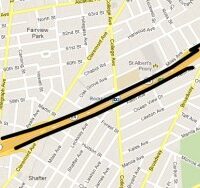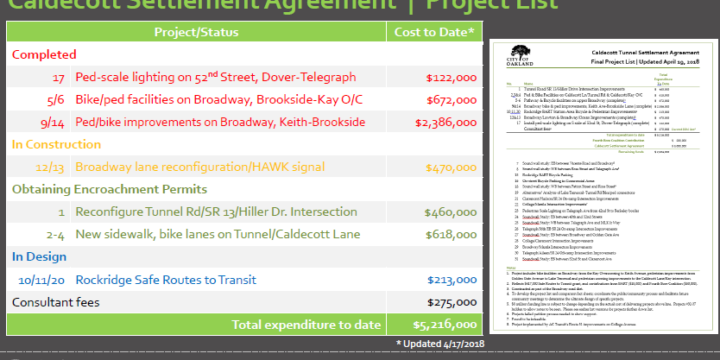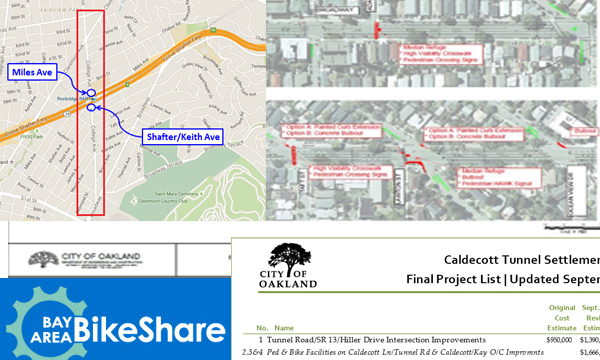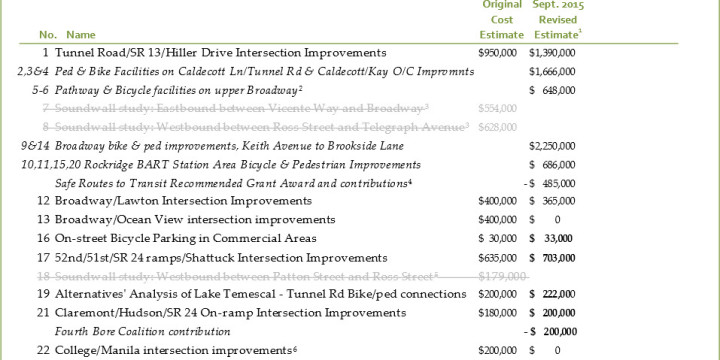Oakland Hosts Public Meeting on Caldecott Settlement Soundwall Studies Sept. 27

Updated 3/25/13: The City of Oakland Caldecott soundwall study petition is now available. A City of Oakland letter announcing the petition process was mailed to eligible signers.
Updated 1/17/13: Memorandum “Questions/Answers at 9/27/12 Soundwall Study Meeting” is now available, written by City consultant Victoria Eisen.
September 24: The next chapter in the process of determining the future of soundwalls at three State Route (SR) 24 locations in Rockridge and Temescal will unfold starting at 7 p.m. Thursday, September 27, at the Rockridge Branch Library.
At this informational meeting, sponsored by the city of Oakland, city and Caltrans staff and their consultants will:
1. Provide a history of the Caldecott Tunnel Settlement Agreement funding and why soundwall studies are eligible
2. Explain the dynamics of freeway noise and how soundwalls work
3. Go over the visual aspect of soundwalls
4. Present the findings of a 2009 study of potential soundwall locations in the area, and
5. Discuss next steps in the process of gauging community sentiment for soundwalls at particular locations.
The City circulated an Invitation for Rockridge Soundwall Meeting to property owners within two blocks of the soundwall study locations.
Fourth Bore Settlement Agreement
As readers of The Rockridge News may recall, in 2008 the city received an $8 million settlement from Caltrans over the environmental assessment of the fourth bore of the Caldecott Tunnel. According to the terms of the settlement, this funding was to be used for projects that “have as their primary purpose the improvement of pedestrian, bicycle, transit and local street improvements, noise barriers, including projects that support the use of transit (and the reduction of single-occupant motorized vehicles, such as transit signal coordination and amenities), to the greater community in the Highway 24 corridor between I-580 and the Caldecott Tunnel.”
In 2010, the city initiated a community process to determine how to spend the settlement. Walking tours were held in the neighborhoods covered by the agreement: North Hills nearest the tunnel, Rockridge and Temescal. Based on a preliminary project list that was part of the settlement agreement and conversations on the walking tours, a new draft list was developed, and was presented and discussed at a public meeting last year. The city received over 250 comments on the projects on this list. This input informed the final project list, which includes “noise barrier” or soundwall studies at the following three locations:
■ Eastbound between Vicente Way and Broadway
■ Westbound between Ross Street and Telegraph Avenue
■ Westbound between Patton Street and Ross Street.
Although the settlement fund is not nearly sufficient to cover the cost of constructing even one of these soundwalls, the city would need to study further one or more of these projects in order to apply for state construction funding.
Soundwall Studies
In 2009, Caltrans commissioned a noise study of SR 24 between SR 13 and I-580 to determine the feasibility of soundwalls along the corridor. The study – known as a “pre- NBSSR” (Noise Barrier Scope Summary Report) – looked at nine potential locations along the Rockridge/Temescal corridor (five eastbound and four westbound). It measured current noise levels near the freeway, predicted the effectiveness of soundwalls at each location, and compared this data with Alameda County Transportation Commission (Alameda CTC) soundwall construction funding criteria. The study concluded that four of the nine locations would meet the criteria Alameda CTC uses to assess applications for state soundwall construction funding. These four segments include the first two in the bulleted list above (Eastbound between Vicente Way and Broadway, and Westbound between Ross Street and Telegraph Avenue), but not the third (Westbound between Patton Street and Ross Street), which the study concludes is “estimated to provide no benefit to affected residences.”
Alameda CTC’s criteria for funding the construction of soundwalls at a particular location are:
■ The existing or future predicted exterior noise level is 65 decibels (dB)
■ A reduction of at least 5 dB resulting from the installation of a soundwall can be achieved
■ The projected cost will not exceed $45,000 per dwelling unit affected by the soundwall (based on year 2002 costs)
■ The residences were developed prior to opening the freeway to traffic.
Now that the city knows which soundwall segments on the funding list satisfy Alameda CTC’s criteria, if it chooses to pursue one or both of these projects, it will need to conduct a full NBSSR. NBSSRs differ from pre-NBSSRs in their depth and breadth. An NBSSR is a full Project Study Report, an engineering report that documents agreement on the scope, schedule, and estimated cost of a project so it can be considered for future state construction funding. Given the expense of an NBSSR, jurisdictions undertake them only when they have the intent to build the studied project(s).
More: September 27 Meeting
Beyond discussing in more detail the historic and technical issues raised in this article, Oakland staff will present a process for determining whether settlement funds should be spent for further study of the potential for soundwalls at various locations in Rockridge and Temescal and how that process compares to existing similar city procedures and those used by other public agencies.
Meeting participants will have the opportunity to ask questions of any of the presenters, and to comment on staff’s proposed decision-making process.
For more information about the September 27 meeting or the Settlement Agreement process and projects, please contact the city of Oakland’s Caldecott project consultant, Victoria Eisen, at 510/525-0220, or e-mail victoria@eisenletunic.com.
The 2009 pre-NBSSR is available here.
View Caldecott Settlement Soundwall Study in a larger map
MEETING POWERPOINTS NOW AVAILABLE:


